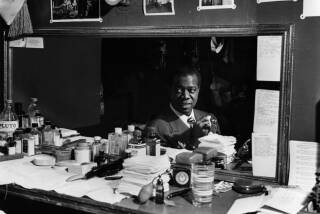Composer and Music Critic Virgil Thomson Dies at 92
- Share via
Virgil Thomson, the critic and composer who mixed the historical ingredients of music into a blend of luxuriant harmonies that stood in stark contrast to the wild experimentation of his time, died in his sleep early Saturday at his apartment in New York’s Chelsea Hotel.
Thomson, who as a newspaper commentator once described Jascha Heifetz’s oeuvre as “silk underwear music,” was 92. He was said to have been one of the prime reasons the world of international art accepted the modern American musical idiom.
Thompson succumbed to a “long-term illness,” according to his secretary, Jeffrey Adelson.
Thomson, who never married, is survived by a niece, Betty Stouffer, of Longwood, Fla. He will be buried in a family plot in Slater, Mo. A memorial service is planned at the Cathedral of St. John the Divine in Manhattan on Nov. 25.
For 70 years, either by himself or with such literary legends as Gertrude Stein, the cherubic sage of American music churned out a large number of operas, ballets, symphonies and chamber works, melding into them American folk tunes, hymns and even cowboy songs.
They proved permanently palatable if not outrageously popular.
And from 1940 to 1954--as he continued to compose memorable melodies--he also manufactured acerbic and provocative prose as the New York Herald Tribune’s music critic in a style one writer likened to “letters home to Aunt Phyllis.”
Some of those “letters,” however, might have offended that maiden aunt’s sensibilities. Such as the time he wrote that Sibelius’ Second Symphony was “vulgar, self-indulgent and provincial beyond all description.” Or the review of “Porgy and Bess” that noted that “its faults are numberless but its inspiration is authentic, its expressive quotient high.” Or that a Vladimir Horowitz trill was “in every way the berries.”
His feud with Heifetz ended only with the legendary violinist’s death in 1987 and reflected only a minor portion of the Thomson credo, one he had formed in his youth and never abandoned: that the quality of the music is vastly more important than the capabilities of the performer.
He also offered not just critiques of music and musicians but his feelings about the composers themselves.
“Mozart,” Thomson once fumed as he summed up his view of the personal failings of the major composers of the Western world, “was not, like Wagner, a political revolutionary. Nor was he, like Beethoven, an old fraud who just talked about human rights and dignity but who was really an irascible, intolerant and scheming careerist. . . . unjust toward the poor, lickspittle toward the rich, dishonest in business, unjust and unforgiving toward the members of his family. . . . “
More important to 20th-Century criticism than the postulations themselves was the historical position of their author.
Wrote About Modern Music
Virgil Garnett Thomson came into the critical arena when it was dominated by men who considered anything written after 1899 unworthy of note. Thomson not only caught the world’s attention with his scathing diatribes but in his travels wrote of such postwar composers as the German Carl Orff and the Frenchman Pierre Boulez. The masses were reading of the music of their own time--and thus making of Thomson a major figure in the modern music movement.
By the end of his tenure at the Herald Tribune, he had established critical credentials as impressive as those he had earned earlier for his music.
Probably the best known of the hundreds of works the prolific Thomson composed were three operas: “Four Saints in Three Acts,” “The Mother of Us All” and “Lord Byron” plus, curiously enough, some film scores. One of them, “Louisiana Story” in 1948, was awarded the only Pulitzer Prize for distinguished musical composition ever given to a film.
That disparity is typical of the Thomson diversity. If his music shares a common thread at all it is one linked to his boyhood years in Middle America. He was born there--in Kansas City, Mo., the son of a postal clerk who had wed a woman whose English ancestors settled Virginia. The lure of Americana was intrinsic.
He took his first piano lessons when he was 5 and by 12 was performing professionally at churches and local concerts. Thomson was an academic prodigy as well, and showed an early interest in composition, which he would follow at college.
He attended officers school at Columbia University after enlisting in the Army in 1917 but the Armistice prevented him seeing active service.
Studied in Paris
He enrolled in Europe, took classes in musical composition and writing and, inspired by Amy Lowell’s poem, “Vernal Equinox,” managed his first composition, a song. He also was a singer and toured Europe with the Harvard Glee Club. When the others returned he remained to study with Nadia Boulanger in Paris.
He eventually came home, graduated from Harvard in 1923 and taught there while writing music and articles on music for Vanity Fair.
When his financial situation failed to improve he told friends that if he were to starve as a composer he “preferred to starve where the food is good.” He returned to Paris and settled on the Left Bank where he composed “Sonata da Chiesa,” a traditional piece in contrast with the dissonance prevalent in music of the 1920s.
Thomson, the critic Harold C. Schonberg of the New York Times once observed, wrote on the “white keys” in “a period when desperate dissonance was in fashion.”
In 1926, he was introduced to Gertrude Stein. He already had become attracted to her experiments with language and, after meeting her, wrote a cantata based on her “Capitals, Capitals.”
The following year they began work on what most critics believe will be Thomson’s most enduring musical legacy: “Four Saints in Three Acts.” Essentially it was an opera of nonsense, blending humor and metaphor in what alternately is America and 16th-Century Spain. The allegory is filled with Stein-isms (its most famous “Pigeons in the grass alas”) and its production marked the melding of the talents of John Houseman (director), Frederick Ashton (choreographer) and Florine Stettheimer (the immortal cellophane and glass bead sets).
It was half acting and half dance as the saints erect their cathedrals in a setting that Thomson said was “like the artistic life that we (the Bohemian expatriates of Paris) were all living.”
Performed Six Years Later
Finished in 1928, Thomson’s haunting masterwork--which features closer to 40 than four saints and involves four, not three, acts--was not produced until 1934. When it was, Thomson’s tuneful score juxtaposed against Stein’s avant-garde, free-spirited libretto made him an overnight sensation.
(The original cast was all black, creating additional tempest at a time when blacks were used only in black-related themes and not in hymn-like and hypnotic ventures into things theological. Blacks were used, Thomson said in a 1981 interview because of their “beauty.” “Blacks sing so beautifully and they look so beautiful.”)
Although it is resurrected occasionally, “Four Saints,” has never been staged at the Metropolitan Opera or New York City Opera.
More popular, successful and more frequently performed was a second and much later collaboration with Stein, “The Mother of Us All,” an operatic paean to Susan B. Anthony written in 1946-47. In it Thomson sprinkled American dances, marches and hymns and folk songs in quilt-like manner. The critic Schonberg said it “may be recognized as one of the few examples of genuine Americana on the lyric stage.”
Thomson spent the years after “Four Saints” in Paris, leaving only when the Germans invaded France. Although it was a relatively bleak period in his professional life as far as performances were concerned, with the dissonant writers in fashion, Thomson did write music for New York shows including “Macbeth” in 1936, in which Orson Welles directed a black Federal Theater cast.
After returning to the United States in 1940, he wrote some radio background music, particularly for the CBS Workshop broadcast of “The Trojan Woman” and then reunited with Stein for “The Mother of Us All” which has been staged more than 3,000 times.
In addition to “Louisiana Story,” other films Thomson scored included “The Plow That Broke the Plains” and “The River,” both with Midwestern backgrounds much like the composer’s own, “The Goddess” and “Voyage to America,” actor-director Houseman’s documentary about immigrants to America.
Musical ‘Portraits’
He also began working on his “portraits,” scores of musical piano tributes of people he admired. They ran the gamut from Picasso to Aaron Copland to Fiorello LaGuardia.
He wrote a ballet--”Filling Station”--for Lincoln Kirstein’s Ballet Caravan in 1937, preceding Copland’s scoring for such American dance pageants as “Billy the Kid” and “Rodeo.”
In 1972 he wrote his third opera, “Lord Byron,” a tribute to George Gordon Byron, the defiant, melancholy British poet. It was performed by the Juilliard School in 1972 but seldom seen again.
Thomson’s 85th birthday, in 1981, sparked a series of parties and the publication of “A Virgil Thomson Reader,” a 582-page anthology of the best of his written criticism. The 5-foot-5 composer was saluted at parties throughout New York and interviewed by fellow critics in the old-fashioned elegance of the Hotel Chelsea in Manhattan where he had lived for years.
His 90th birthday was less frenetic but did result in more desultory interviews in which the lifelong bachelor refused to evaluate himself or his music for posterity. He did tell a writer for New York magazine that “it (the music) lives its own life. But I suspect that long from now, when things have settled down, Copland’s ballets and my operas will remain.”
As to his unique and distinctive career as both artist and critic, Thomson observed “it takes three people to make music properly: one man to write it, another to play it and a third to criticize it.
“Anything else is just a rehearsal.”
More to Read
The biggest entertainment stories
Get our big stories about Hollywood, film, television, music, arts, culture and more right in your inbox as soon as they publish.
You may occasionally receive promotional content from the Los Angeles Times.










